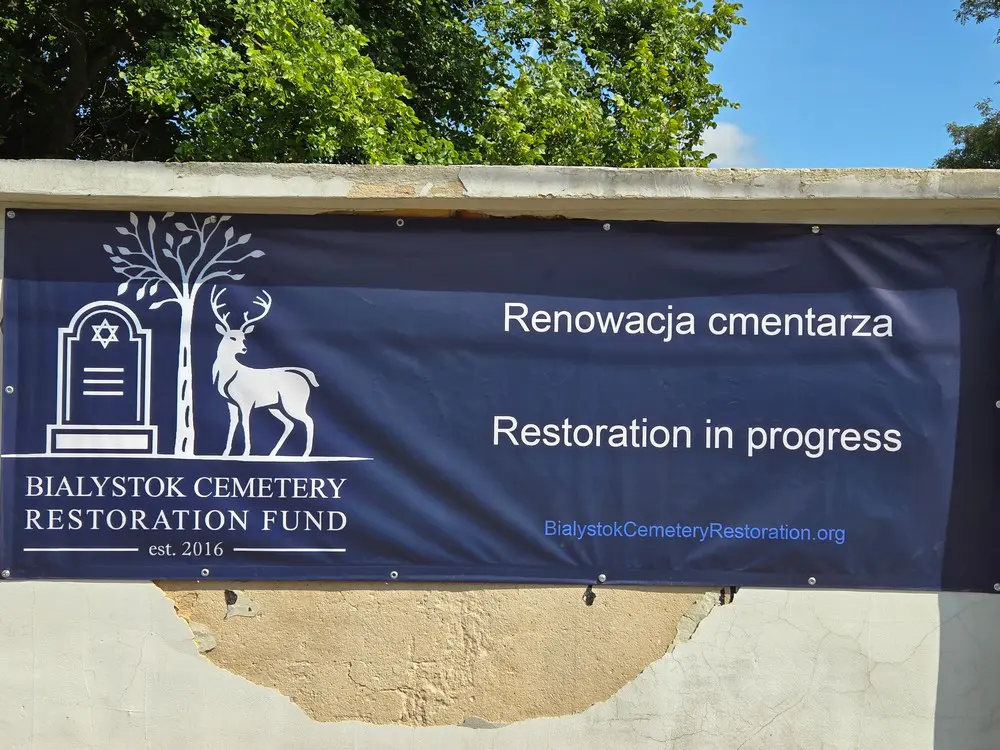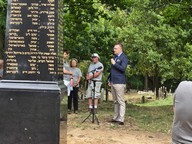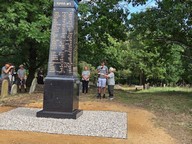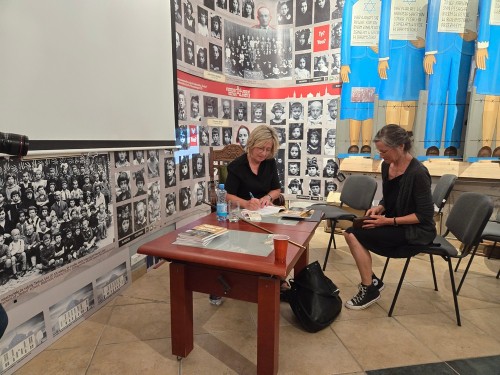Bialystok Cemetery Restoration Fund End-of-Year Report 2024
by Josh Degen, Amy Halpern Degen and Heidi M. Szpek, Ph.D.
The Bialystok Cemetery Restoration Fund (BCRF) conducted its annual 2024 working trip at Bagnowka Cemetery in Bialystok Poland. The BCRF began its restoration work in 2016 and, as of the end of the 2024 trip, we have reset well over 3,000 matzevoth (tombstones). This past year, we had 18 international volunteers including a rabbi, and three students from Suffolk University of Boston, MA as well as over 20 Bialystokers volunteering at the cemetery.
This was a very special year because we utilized different equipment than previously used to assist lifting and resetting tombstones. This past year, we engaged the use of a spider crane that had the ability to work from the aisles in between sections in the cemetery. Unlike years past where we used an excavator that only had a 16 ft. reach, many matzevoth in the center of each section were left behind to await the ability to reset them to their rightful gravesite. The compact spider crane had the ability to reach 60 feet in all directions. This was a game changer and allowed us to complete sections and begin lifting in new sections. By the end of the work session we lifted a whopping 1,018 stones, 600 more than in any other previous summer. We also lifted 90 stones by hand totaling over 1,100.
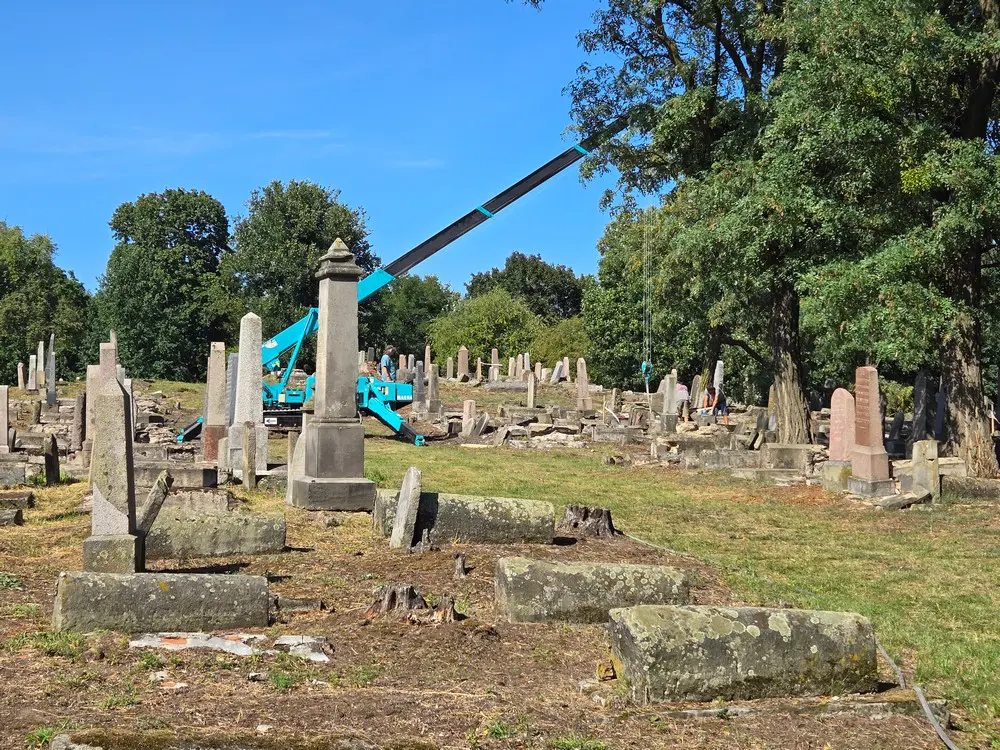
Over 1000 stones were washed or brush-cleaned and photographed to assist in documentation, with 334 new stones added to the database with full vital details and inscriptions. Vital details from 949 stones were also added to the Bagnowka Cemetery database. Ninety stones were too rugged or lichen-covered to be properly cleaned and documented this year due to time constraints. It is not uncommon that select stones are revisited in the following season in order to properly record vital details. Four historic tombstones were repainted as the BCRF continues to evaluate the value and longevity of repainting tombstones. Tombstones poorly painted by non-BCRF volunteers in the past were also cleaned to best reflect the inscription.
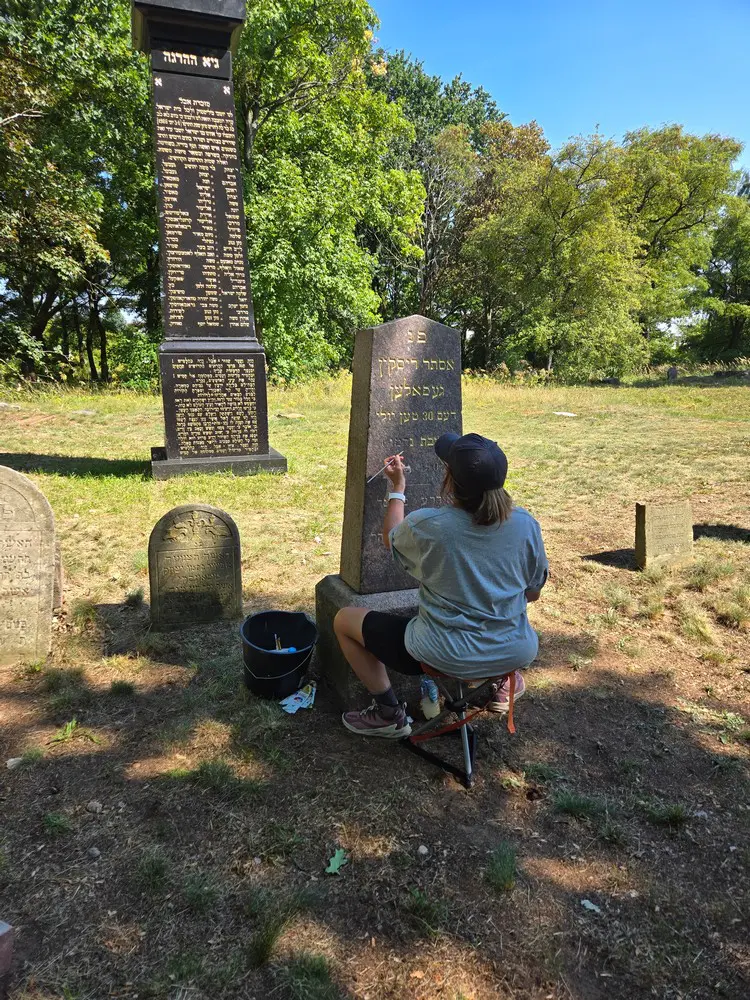
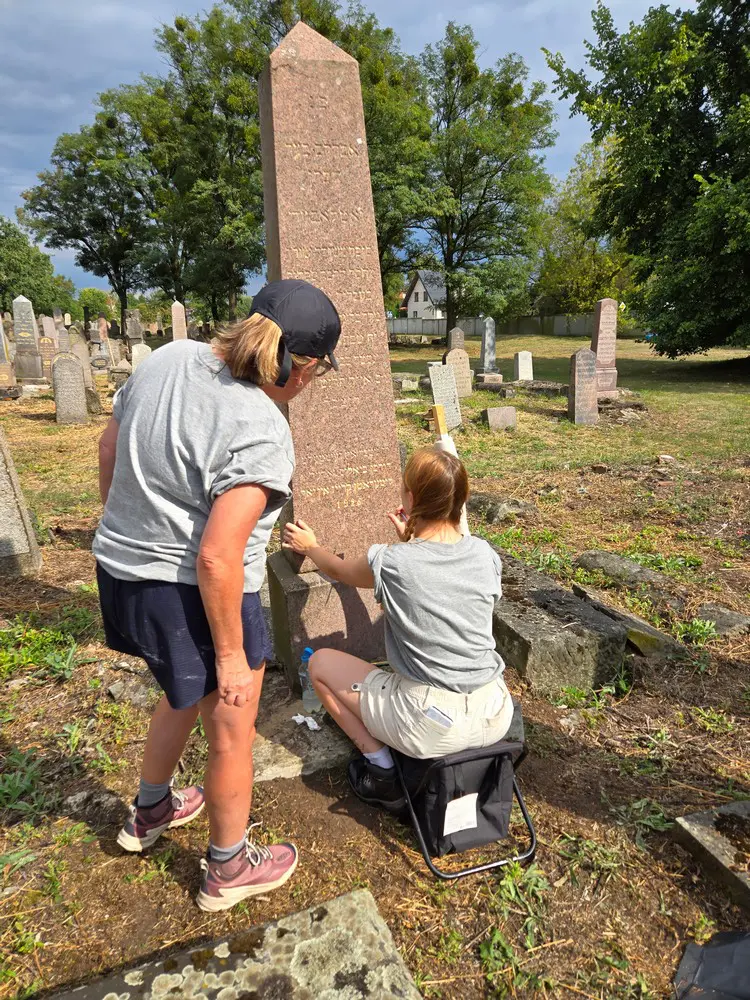
New database records were uploaded to the JewishGen Online Worldwide Burial Registry (JOWBR) thanks to the efforts of BCRF volunteer Asher Arbit and JOWBR’s Nolan Altman, thus increasing the Bagnowka records uploaded in May 2024 from 3428 to 4615. These records will be reviewed during the Winter of 2024-2025, with revisions submitted in May 2025. An updated master database will also be uploaded to the BCRF website in early 2025.
The City of Bialystok cleared three additional sections of the north wooded area of the cemetery. These sections plus those cleared last year had to be completely raked first in order to access and uncover matzevoth. The clearing of these sections enabled us to reset many more matzevoth. This year we added two steel baskets in the Memorial Area, in which we placed fragments of matzevoth too small to be identified and placed in a rightful burial plot, as well as several complete matzevoth discovered beneath the old foundation for the Memorial Pillar. Each piece was numbered and photographed to record its precise location and will eventually be placed in a lapidarium in the Cemetery. The City of Bialystok continued to provide ongoing grass cutting to allow us to work in the Cemetery plus provide public access to view this beautiful gem from a time lost prior to the Holocaust.
During the Summers of 2022 and 2023 the BCRF recovered approximately 150 matzevoth from two artificial mounds located outside the Bagnowka borders. These tombstones dated from prior to 1850. Bagnowka Cemetery was opened in 1890. The only operating cemetery at the time of the death of the individuals was the Rabbinic Cemetery located in the center of Bialystok. While under Communist Rule the cemetery was intentionally destroyed to make way for the current Central Park. The BCRF has been working with renowned local architect Dr. Jerzy Uścinowicz (Bialystok Polytechnic University) who pro bono designed and submitted plans to build a symbolic memorial at the Central Park for these stored matzevoth adjacent to the former Rabbinic Cemetery. The plan has been fully approved by the City of Bialystok. The last remaining hurdle is to fundraise $200,000.00 to implement this plan.
The BCRF has worked closely with Dr. Tomasz Wisniewski for many years. Tomek opened the only Jewish Museum in Bialystok, called Miejsce (The Place) in the city center. His museum documents the Jewish history of Bialystok and preserves its memory. This August, Tomek hosted a Shabbat service sponsored by the BCRF. Rabbi David Kudan, one of our volunteers, conducted what may have been the first Shabbat services since the late 1960s! Stunningly over 100 people, mostly local non-Jews, packed the museum to participate in the service. It was a special and wonderful evening.
The walls along Bagnowka Cemetery have been deteriorating for many years. The City of Bialystok owns the cemetery thus has the responsibility for their removal and replacement. The BCRF has been lobbying the city to replace them. Last summer, we were invited to the Planning Department where we viewed the approved plans for the wall replacement. This action demonstrates the city’s commitment to ongoing site improvements at Bagnowka Cemetery. The BCRF had committed to supplying wrought iron gates at the entrance if the city replaced the walls. The project needs to be approved by the City Government during the budgeting process and will be implemented in phases. The BCRF is seeking targeted funds of approximately $30,000.00 to fulfill our commitment to this much-needed project.
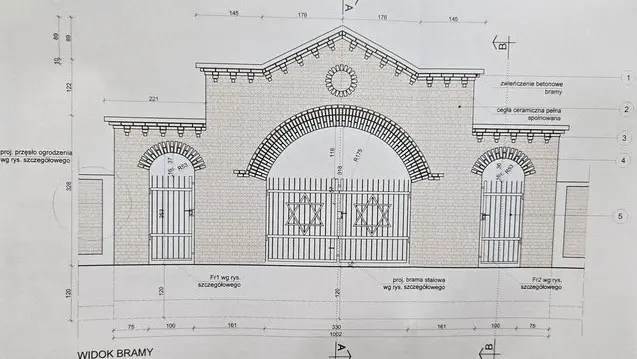
Every year, particular discoveries or restorations are monumental and mark the uniqueness of that season’s work. This year, the rededication of the Memorial Pillar that remembered victims of the 1906 Pogrom in Bialystok and two 1905 Massacres distinguished this season. On Sunday, August 11, 2024, the Memorial Pillar was rededicated. BCRF board members, volunteers, and visitors from Bialystok and environs joined in this momentous event. BCRF Chair Joshua Degen introduced the ceremony, welcoming visitors and reminding visitors of the incredible progress that has occurred in the restoration of Bagnowka Cemetery. Dr. Heidi Szpek, BCRF Vice-Chair, translator and historian delivered a most telling speech, reminding visitors that “114 years ago, members of the Bialystok Jewish community gathered on this very spot to erect and dedicate the original pillar.” Bialystoker and BCRF Treasurer Amy Halpern Degen spoke of her personal connection to Bialystok and the cemetery, and introduced college friend and current BCRF volunteer Randi Cohen, whom visitors learned was a descendant of one of the victims of the 1905 Shabbat Nahamu Massacre, Gitel Zakheim, age 25, and her little brother, Arieh Leyb, son of David Chaim Zakhejm, age 10, who died in the 1906 Pogrom. Bialystok Vice-President Rafal Rudnicki was also invited to speak; he shared his thoughts about the incredible restoration on the cemetery as well as this magnificent memorial. The ceremony concluded with the Hebrew prayer El Male Rahamin, led by Bialystoker and BCRF volunteer Asher Arbit. Members of the media were in attendance; newspaper articles and a video of the pillar’s restoration were produced in response to this momentous event. Restoration of the Pillar was conducted between June and November 2023 by Warsaw conservator Bartosz Markowski, coordinated by local BCRF board member Andrzej Rusewicz. Just days before the rededication local landscapers donated their time and resources to landscape the circumference of the pillar. The $40,000 restoration cost was through the exceptional fundraising of Josh and Amy Degen. In honor of the rededication, Dr. Heidi M. Szpek published a monograph entitled, Pillar of Sorrow: The Story behind the Memorial Pillar to the Victims of the 1905 Massacres and the 1906 Pogrom in Bialystok, available at Amazon.com. Dr. Wisniewski hosted a book talk and signing at The Place. Plans are underway to also create a memorial plaza with engraved bronze pavers for those victims not remembered on the pillar. For updates visit the BCRF website www.bialystokcemeteryrestoration.org or contact BCRF president, Josh Degen, for cost estimates.
Each year, there are several tombstone discoveries that touch our souls. While many will be shared in the coming year, three are presented here. This season, as noted, 1018 tombstones were lifted via the spider crane. At the monumental #1000, all volunteers present stopped for this photo capture.
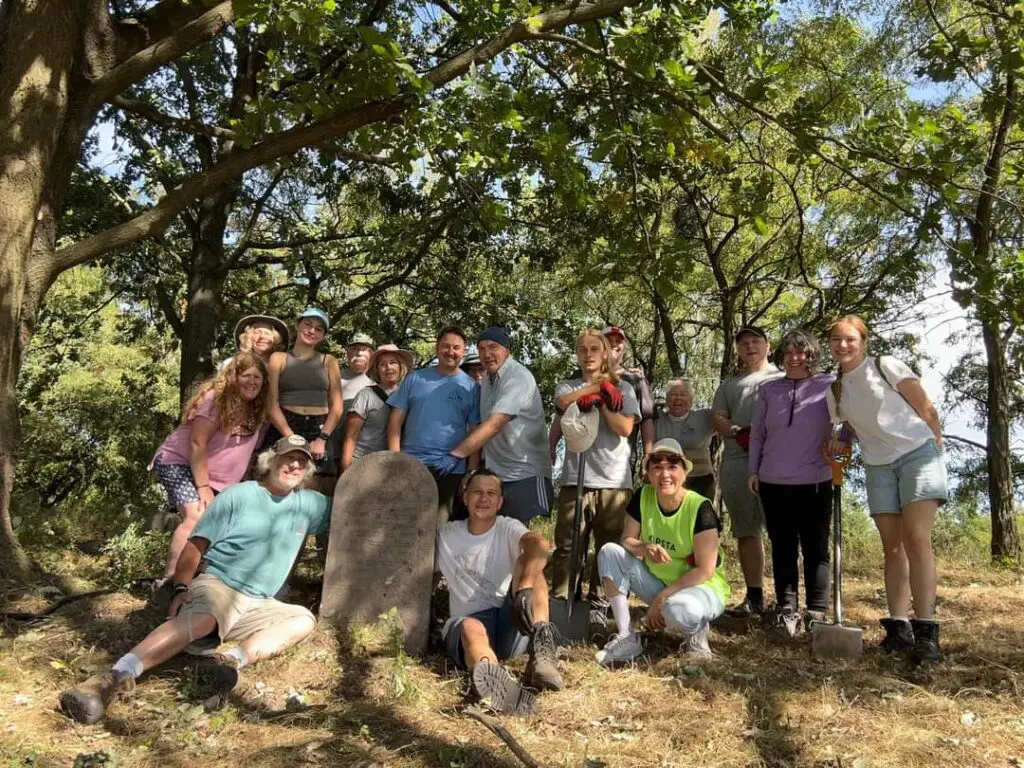
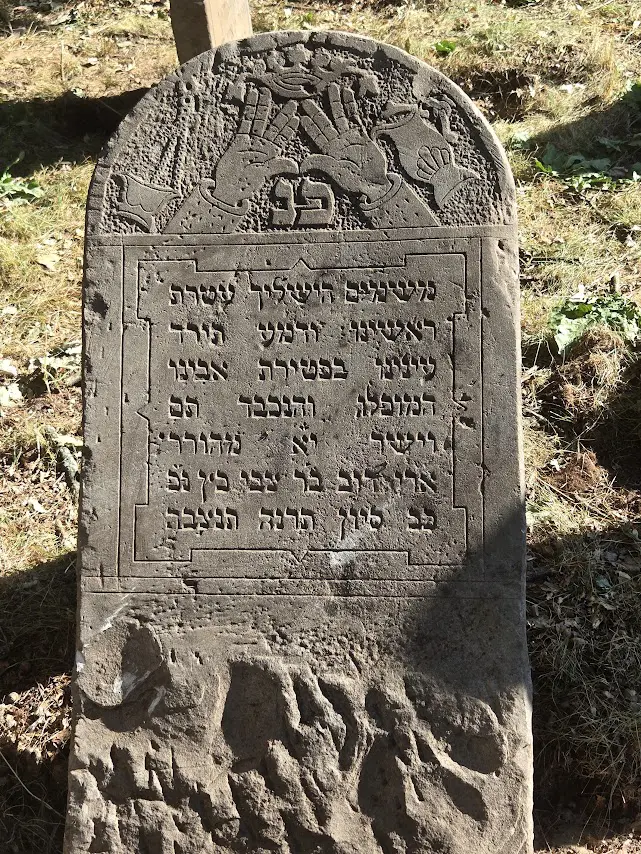
Another chance discovery occurred when the ornamental register to a Sephardic horizontal style burial marker was discovered. Beneath that megalithic cap lay buried another complete tombstone, fractured by the weight of the cap. The pieces were turned revealing a one-of-a-kind Ashkenazi tombstone for a woman. What was so provocative? Her tombstone held an image of what is believed to be the Great Synagogue in Bialystok. While at least two tombstones on Bagnowka bear images of a synagogue or beth midrash, neither is for a woman. This tombstone remembers a Malka, daughter of Shmuel, who died on 12 Elul 5660 [24 August 1900]. No surname was engraved but thanks to the archival research of Dr. Szpek and Frank Idzikowski, a death record for a Malka on this specific date was discovered. Thanks to Johanna Czaban, a Jewish heritage preservationist in Krynki, Poland, translation of the old Russian archival record was arranged. Malka’s full name is Malka Shmuelevna Poznyak. She was 50 years old and as her tombstone also noted, she died suddenly. Research now begins to determine what connection Malka has to what may be the Great Synagogue in Bialystok. This tombstone is currently under restoration in Warsaw by the talented Bartosz Markowski. Its restoration cost is $7000. Those wishing to contribute to it restoration can contact BCRF treasurer, Amy Halpern Degen.
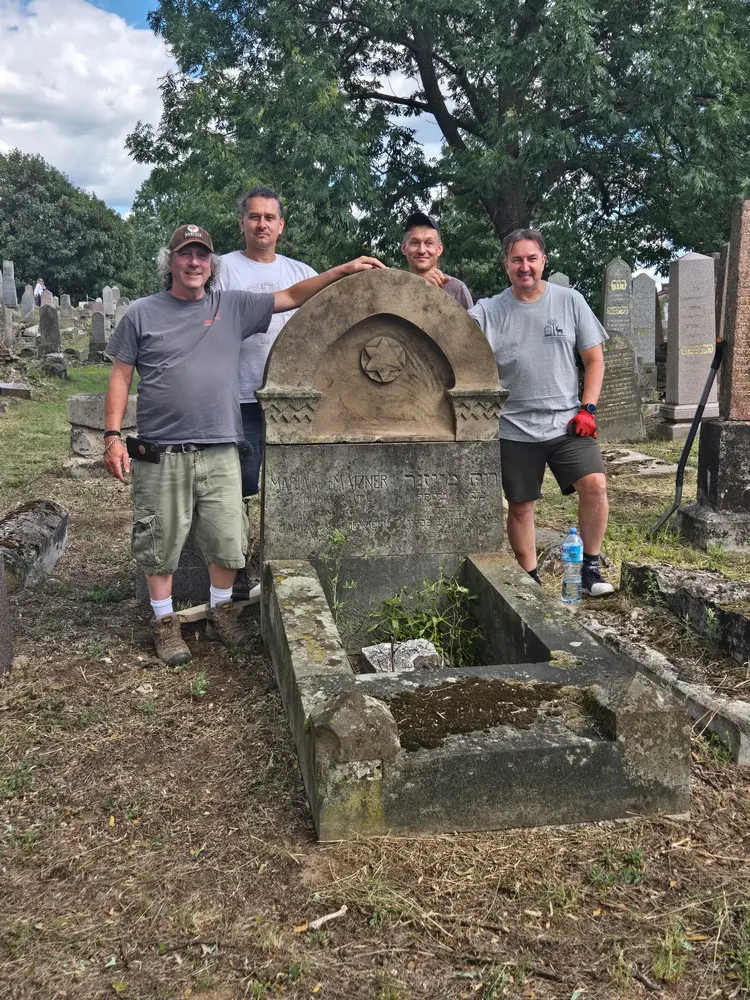
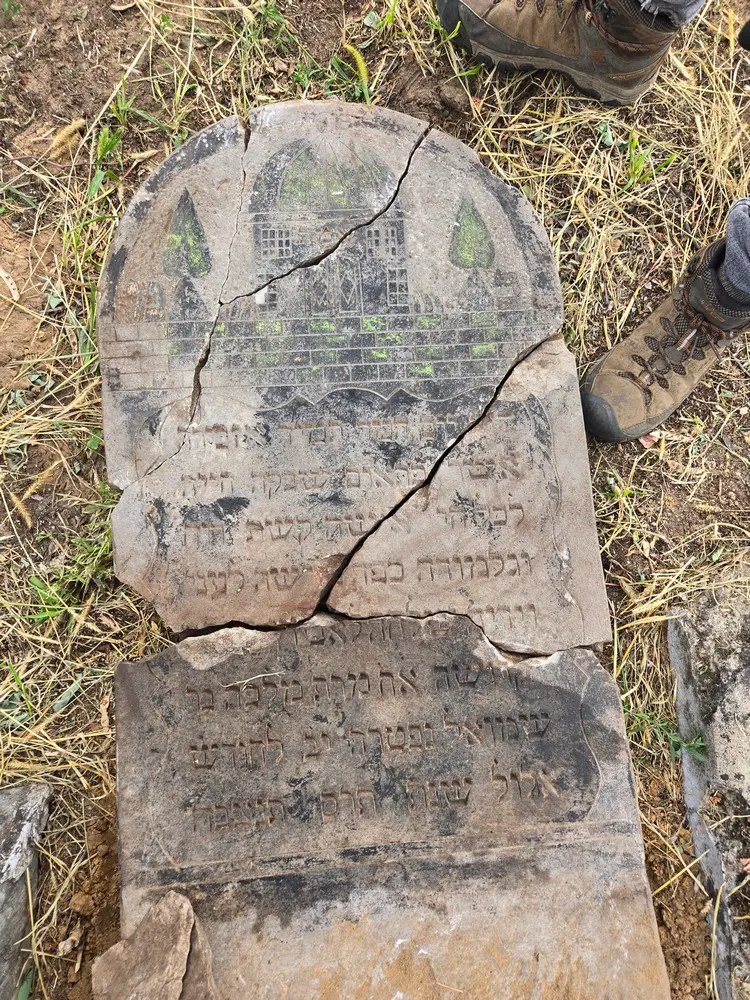
Finally, as the lights of Hanukkah 2024/5785 haved dimmed, the dramatic epitaph of a double tombstone for two brothers is offered here, cleaned by Deborah Arbit and translated by Asher Arbit. Its setting amidst Hanukkah 5660 (1899) is timely.
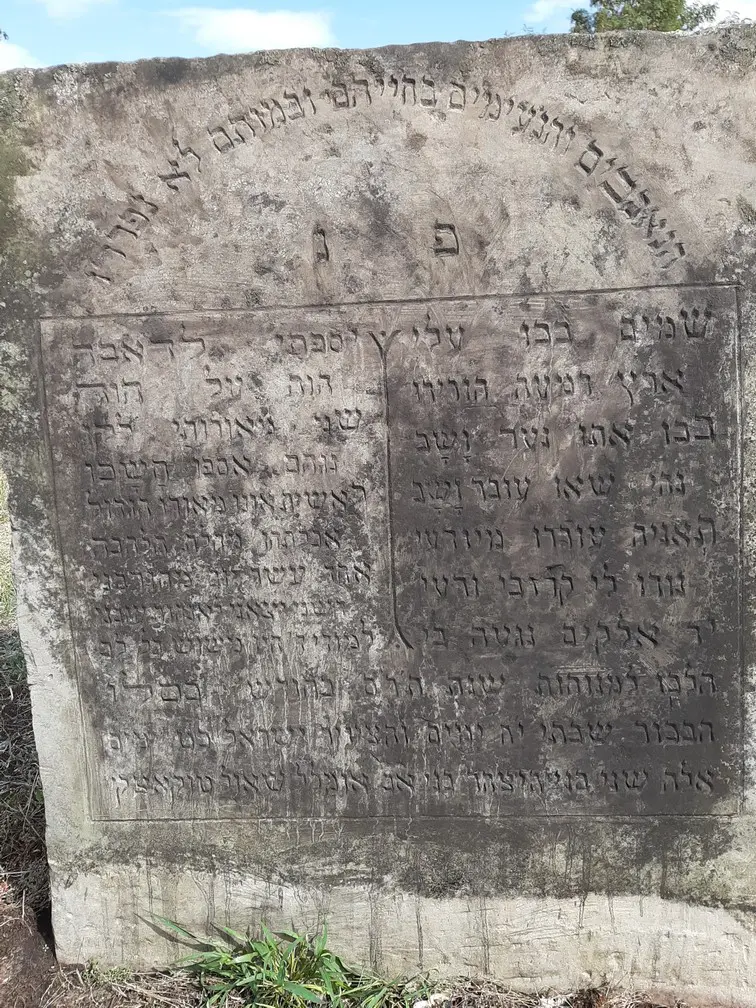
“Beloved and pleasant in their lives, even in their death they were not separated.” [2 Samuel 1:23] Here are buried: (r.) The heavens cried; the earth shed tears. / People wept over the child; passersby sobbed. / Friends mourned, loved ones bowed their heads. / The hand of God touched me. (L.) My sorrow deepened; calamity followed calamity. / Both of my luminaries were eclipsed; their light was taken away and they darkened. / The firstborn was like the sun and was consumed by the plague. / Eleven days after my first catastrophe, the second one brought me to eternal sorrow. / But Torah study can gladden [even the most sorrowful] heart.] They went to their final resting place in Kislev 5660 / The firstborn, Shabtai, on the 18th [of Kislev] and the younger, Yisrael, on the 29th [of Kislev] / These “two anointed ones” were the sons of a desolate father, Shaul Tukotzki.”
Note: The metaphors of light and darkness and of “the anointed ones” are both connected to the death of the second son during the “Feast of Lights”, i.e., Channukah, where the “lights” are traditionally olive oil lamps. The phrase “consumed by the plague” could have been literally translated as “consumed by the flaming sickness” in keeping with this motif.
The rhyming acrostics spell out the names of the brothers: Shabtai (right column) and Yisrael (left column). The verse on the top, quoted from 2 Samuel, is from King David’s majestic eulogy for Jonathan and Saul. Note that the name of the father was Shaul/Saul. (Translation and note by Asher Arbit.)
The BCRF, through its Board of Directors, has forged many alliances and friendships within the local Bialystok Community. We have folks that we can rely upon to keep eyes on Bagnowka to ensure its safety as well as help us navigate the logistics for a successful working trip each summer. The BCRF also has incredibly dedicated volunteers. The following inspirational poem was written by Lisa Porter, who volunteered this past summer. Lisa was a wonderful volunteer and so moved by the project that she took her memories and emotions to words and wrote the following poem. It is moving and captures the essence of working at Bagnowka.
A Stone Carver’s Lament
Bialystok Poland 1880-1950
By Lisa Porter 2024
They come to me
With tears in their eyes
Prayers on their lips.
They have little to offer me
But their expectations are high.
Their loved ones deserve the best.
They come for their fathers and mothers
husbands, wives,
Children.
They ask me to craft art.
Judah’s lion, books, candelabras, beauty.
Representations of lives well lived.
They provide loving words
expressions of character
Status, intellect.
“A woman of modesty,”
“A learned man,” “caring son”
“Brave soldier.”
“He served his country,”
“She gave to community,”
“He died a violent death.”
They want more from me.
Prayers, poems, song.
For words never die.
Except they do.
They are covered by time
Evil, neglect.
When no one is left to carve
Craft, create.
When no one is left words die.
When no one is left to rake
Uncover, clean, visit
Care.
Except we do.
We rake, find, lift, clean, glue, document.
Words rise again! For words never die.
We lost one of our most important volunteers on 12/31/2024, Frank Idzikowski, husband of BCRF Vice-Chair Heidi M. Szpek, Ph.D. Frank gave countless hours doing research and found aerial photographs of the Cemetery taken by the U.S. Government during W.W.II . He photographed each matzevah lifted and this summer photographed each stone fragment in case it could ever be reunited with the rest of its headstone. He will be greatly missed and may his memory be a blessing.
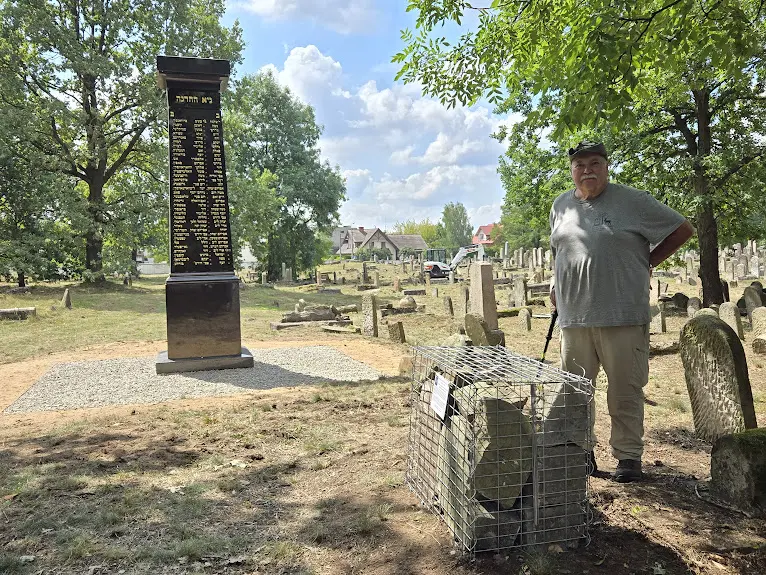
Finally, the 2025 Bagnowka Summercamp dates of restoration have been established. Works begins on August 2, 2025, and concludes on August 15, 2025, followed by the Commemoration of the Bialystok Ghetto Uprising on August 16, 2025. Those interested in volunteering can visit the BCRF website for details www.bialystokcemeteryrestoration.org

